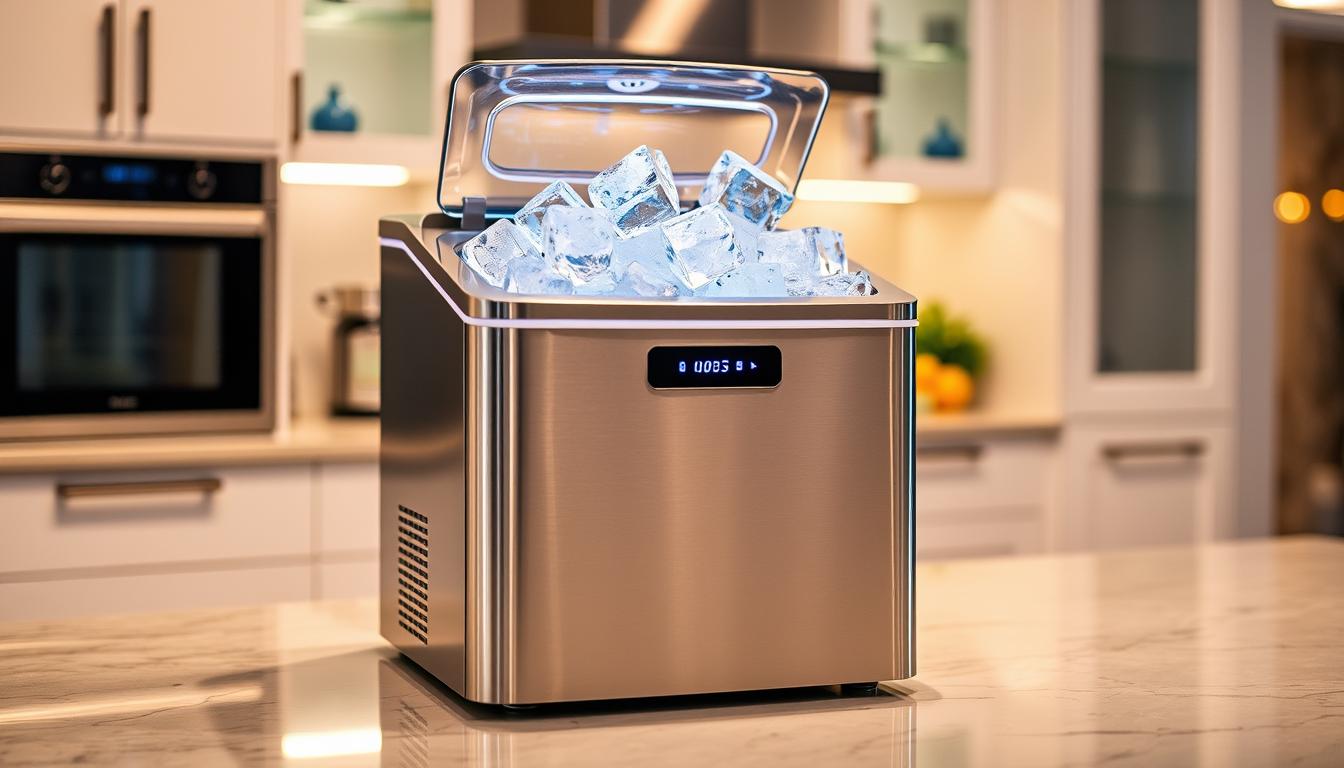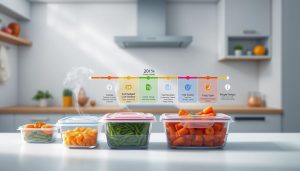Did you know an ice maker in your kitchen can change the game? No more ice cube shortages or long waits. The right ice maker means cold drinks whenever you want.
An ice maker buying guide can help you pick the best one for your kitchen. Think about space, how much ice you need, and energy efficiency. These factors are key to making the right choice.
Key Takeaways
- Understand your ice needs to choose the right capacity ice maker.
- Consider the space available in your kitchen for the ice maker.
- Look for energy-efficient models to save on utility bills.
- Check the ice maker’s production rate and type of ice it produces.
- Additional features like automatic ice harvesting can enhance user experience.
Understanding Your Ice Making Needs
Your ice maker’s success depends on how well it meets your needs. To choose wisely, think about several key factors.
Assessing Daily Ice Consumption
How much ice you use daily is key. It’s influenced by your household size and how often you have guests.
Household Size Considerations
Bigger families use more ice. A family of four or more might need an ice maker that makes more.
Entertainment Frequency Impact
Hosting parties often? You’ll need an ice maker that can handle the demand. Look for one with a big storage capacity to avoid running out of ice.
Considering Available Kitchen Space
Before picking an ice maker, check your kitchen’s space. Measure the area and think about how much room it needs.
Measuring Your Installation Area
Measure the space where you’ll put the ice maker. Make sure it fits and has enough air for ventilation.
Clearance Requirements
Look at the maker’s guidelines for space needs. Some need extra room for air and easy access for upkeep.
| Ice Maker Feature | Consideration | Benefit |
|---|---|---|
| Size | Compact designs for small kitchens | Saves space |
| Capacity | Production capacity matching household size | Ensures sufficient ice supply |
| Drainage System | Self-draining or manual draining options | Convenience and reduced maintenance |
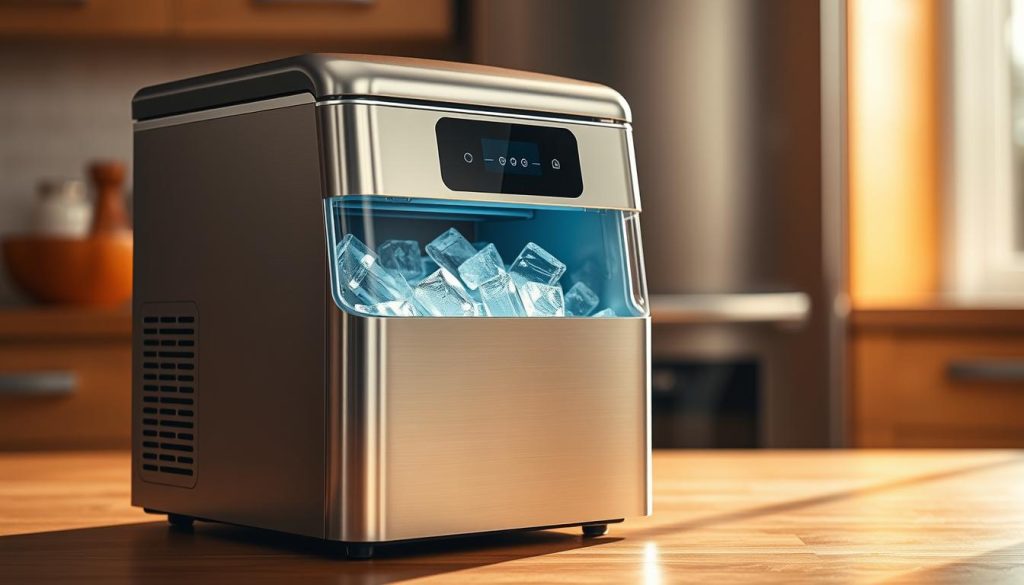
Types of Ice Makers for Home Kitchens
Home kitchens can benefit from several types of ice makers. Each has its own features and benefits. The main categories are built-in ice makers, portable countertop models, and undercounter ice machines.
Built-In Ice Makers
Built-in ice makers fit right into your kitchen cabinetry. They offer a sleek and streamlined look.
Integration with Cabinetry
These ice makers are installed directly into your kitchen’s layout. They ensure a cohesive look that matches your other appliances.
Permanent Installation Considerations
It’s important to think about the permanent installation needs. This includes plumbing and electrical connections for a smooth setup.
Portable Countertop Models
Portable countertop ice makers are flexible and convenient. You can place them anywhere in your kitchen.
Flexibility Benefits
These models are great for those who want to move their ice maker. Or take it with them when entertaining outdoors.
Space Requirements
Countertop models need dedicated space on your counter. Make sure to measure your available space before buying.
Undercounter Ice Machines
Undercounter ice machines fit under your kitchen counter. They offer a compact solution for ice production.
Professional-Grade Features
Many undercounter models have professional-grade features. These include high-capacity ice production and advanced ice-making technologies.
Installation Complexity
The installation of undercounter ice machines is more complex. It requires both plumbing and electrical connections under the counter.
To help you compare these types of ice makers, here’s a summary table:
| Type | Installation | Flexibility | Space Requirement |
|---|---|---|---|
| Built-In | Permanent | Limited | Integrated into cabinetry |
| Portable Countertop | Simple | High | Countertop space |
| Undercounter | Complex | Limited | Undercounter space |
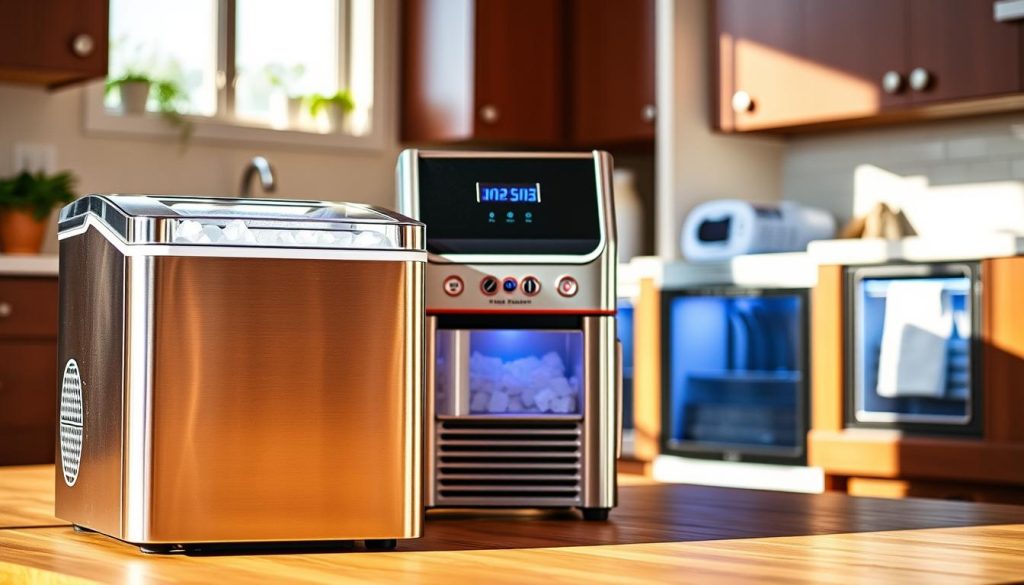
Different Ice Shapes and Their Uses
Ice makers don’t just make ice; they shape it into various forms. Each shape has its own benefits. Knowing which ice shape you need can help you pick the right ice maker for your kitchen.
Cube Ice for Everyday Drinks
Cubed ice is the most common type. It’s great for everyday drinks. It melts slowly, keeping drinks cold without making them too watery.
Melting Rate Comparison
Cubed ice melts slower than other shapes. This makes it perfect for long chats over drinks.
Ideal Applications
It’s best for water, soft drinks, and cocktails. A slow melting rate is desired here.
Nugget Ice for Specialty Beverages
Nugget ice, or chewable ice, is gaining popularity. It has a unique texture and absorbs flavors well. It’s loved by those who enjoy specialty drinks.
Texture Benefits
The soft, chewable texture of nugget ice is comfortable to bite into. It also enhances the flavor of drinks.
Popular Brands Offer Nugget Ice
Brands like Scotsman and Opal make high-quality nugget ice makers. They’re great for home bars or for those who love specialty drinks.
Crescent Ice for Commercial Applications
Crescent ice is used in commercial settings. It’s durable and melts slowly. It’s perfect for businesses that need ice that can handle being handled and stored.
Durability Advantages
The crescent shape has a larger surface area. This makes it more durable and less likely to break.
Home Use Considerations
While often used commercially, crescent ice makers are also good for homes. They’re great for those with high ice needs or who entertain often.
Here’s a comparison of the different ice shapes:
| Ice Shape | Melting Rate | Ideal Use |
|---|---|---|
| Cube | Moderate | Everyday drinks |
| Nugget | Fast | Specialty beverages |
| Crescent | Slow | Commercial applications |
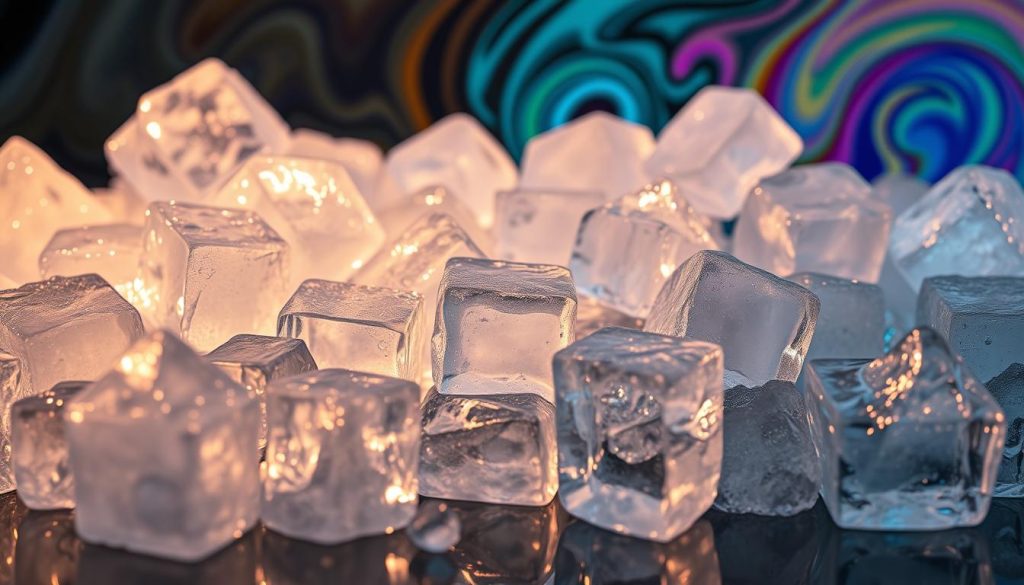
Production Capacity: How Much Ice Do You Need?
To find the right ice maker for your kitchen, think about how much ice you need. Ice makers produce ice in pounds daily. The amount needed varies by household size and entertainment plans.

Small Household Requirements
Small households or singles might prefer an ice maker that makes 9-12 pounds of ice daily. These are great for small kitchens where space is tight.
9-12 lbs Daily Production Models
These ice makers are ideal for singles or couples. They are small, use less energy, and fit on most countertops.
Best Compact Options
Compact ice makers save space and make ice quickly. They don’t need a big installation.
Medium-Sized Family Needs
Medium-sized families might want an ice maker that makes 15-25 pounds of ice daily. These models are a good size and output for most kitchens.
15-25 lbs Daily Production Models
These ice makers are perfect for families who sometimes have guests. They make plenty of ice without taking up too much space.
Balance of Size and Output
These models offer a lot of ice without being too big. They fit well in most homes.
Large Gathering and Entertainment Demands
If you often host big parties, you’ll need an ice maker that makes 30 pounds or more daily. These are built for big needs and add to your entertainment options.
30+ lbs Daily Production Models
These ice makers are great for big families or those who love to entertain. They make sure you have enough ice for everyone.
Commercial-Grade Residential Options
For the highest needs, there are commercial-grade ice makers. They produce the most ice and are made for heavy use.
Storage Capacity Considerations
Choosing the right ice maker is more than just looking at how much ice it makes. You also need to think about how much ice you can store. Ice production and storage are different, and knowing this helps you make the best choice.
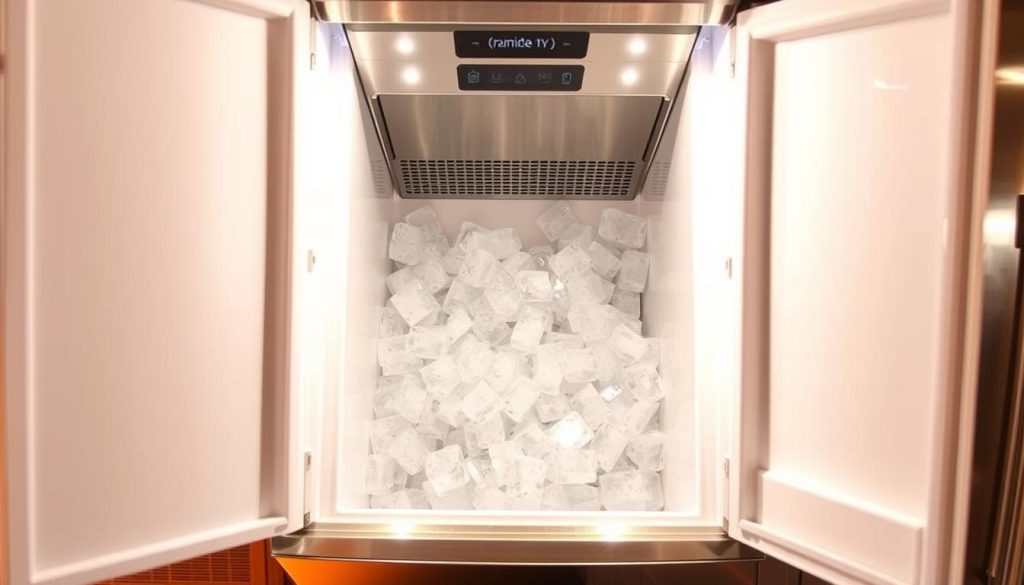
Small Storage Options (1-2 lbs)
If you live alone or with just a few people, an ice maker that holds 1-2 lbs is perfect. These small models are great for putting on your countertop.
Countertop Models Comparison
Countertop ice makers come in different designs and efficiencies. Some brands offer stylish models that look good in any kitchen.
Space-Saving Designs
For small kitchens, space-saving ice makers are ideal. They let you have an ice maker without using too much space.
Medium Storage Capacity (2-5 lbs)
If you have a medium-sized family or like to host guests often, choose an ice maker that holds 2-5 lbs. These models are both small and useful.
Popular Mid-Range Models
Mid-range ice makers are loved for their size and ice storage. They fit well in many homes.
Insulation Quality Comparison
The insulation in these models affects how long ice stays cold. Better insulation means ice lasts longer.
Large Storage Solutions (5+ lbs)
For big parties or commercial needs, you’ll need an ice maker that holds more than 5 lbs. These models often have extra features.
Premium Storage Features
Premium ice makers have advanced storage features. They include better insulation and sometimes smart tech for tracking ice levels.
Ice Preservation Duration
How long ice stays cold depends on the insulation and the design of the storage bin.
| Storage Capacity | Ideal Use | Key Features |
|---|---|---|
| 1-2 lbs | Small households, personal use | Compact, countertop models |
| 2-5 lbs | Medium-sized families, frequent entertaining | Balanced size and functionality, good insulation |
| 5+ lbs | Large gatherings, commercial use | Advanced features, premium insulation, smart technology |
Installation Requirements and Considerations
To get the most out of your ice maker, it’s key to know its installation needs. Proper setup not only makes your appliance last longer but also boosts its performance and efficiency.
Water Line Access Requirements
Most ice makers need a cold water supply inlet to work. The water supply connection can differ; some are plumbed directly, while others use a reservoir.
Direct Plumbing vs. Reservoir Models
Direct plumbing models connect straight to your home’s water supply. They make ice continuously without needing manual refills. Reservoir models, though, need filling now and then but are easier to install.
Installation Complexity Comparison
Direct plumbing models are harder to install because they need a water line connection. Reservoir models are simpler but might need more upkeep.
Electrical Requirements
Ice makers also have specific electrical needs. Knowing these is key for safe and efficient use.
Standard vs. Specialized Power Needs
Most home ice makers run on standard household voltage (120V). But, some big or commercial models might need 240V or special power setups.
Energy Consumption Comparison
Energy use differs a lot among models. Energy Star-rated ice makers are more energy-efficient. They could help you save on utility bills.
Ventilation Needs
Good ventilation is vital for your ice maker’s best performance. It helps get rid of heat made during ice-making.
Front-Venting vs. Rear-Venting Models
Some ice makers vent from the front, while others from the back. Knowing the venting setup is key for right installation.
Clearance Guidelines by Brand
Different brands need different clearances. Always check the maker’s guidelines for enough space around your ice maker for good ventilation.
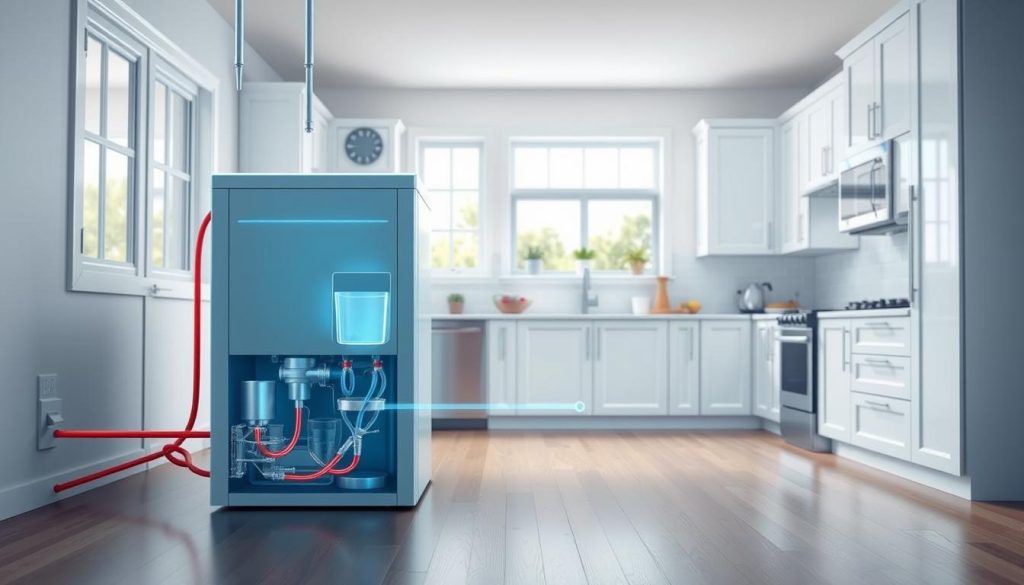
How to Choose the Right Ice Maker for Your Kitchen Setup
Your kitchen’s layout and design should help pick the right ice maker. There are many models out there. It’s key to think about how the ice maker will fit into your kitchen’s look and function.
Matching Ice Makers to Kitchen Layouts
Kitchens are different, so ice makers need to match. For example, if you have an island, look for an ice maker that fits well in that area.
Island Installation Options
For kitchens with islands, think about ice makers that can be built into the counter or stand alone. KitchenAid offers sizes like 15″ and 18″ to fit any island.
Galley Kitchen Solutions
In small galley kitchens, choose compact or undercounter ice makers. They make ice efficiently without taking up too much space.
Aesthetic Considerations and Design Integration
The look of your ice maker is also important. It should match your kitchen’s style. Modern ice makers come in many finishes and designs.
Panel-Ready Models
Panel-ready ice makers can be customized to match your cabinets. This makes them blend in with your kitchen’s look.
Finish Options and Coordination
Ice makers come in finishes like stainless steel or panels that match your appliances. This helps create a stylish and unified kitchen.
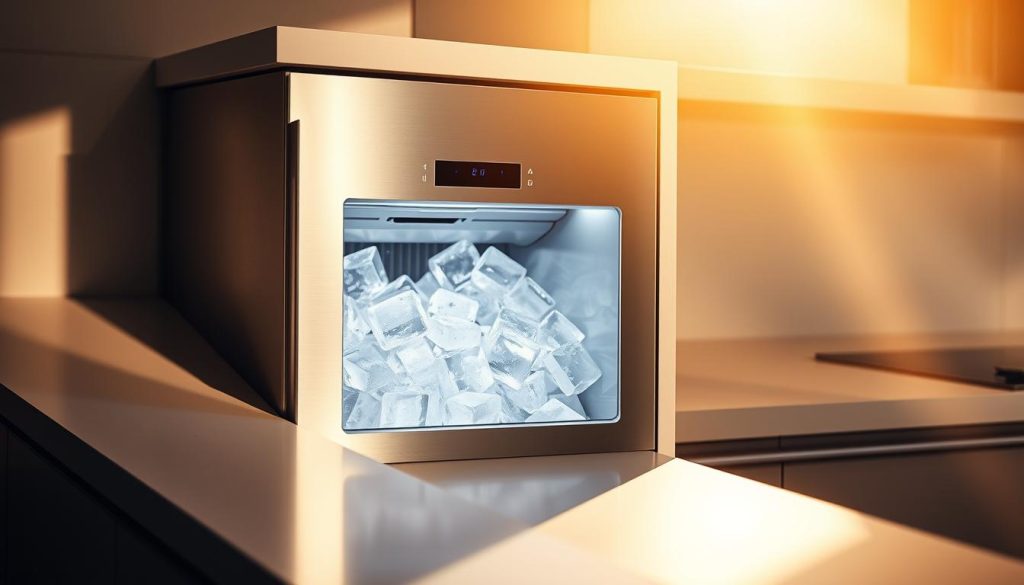
Energy Efficiency and Operating Costs
When looking at ice makers, it’s key to understand their energy use and costs. This helps you choose wisely.
Energy efficiency in ice makers saves money and helps the planet. Look for the Energy Star rating to see if a model is efficient.
Energy Star Ratings Explained
The ENERGY STAR label shows a product meets high energy standards. For ice makers, it means they use less energy. This can cut down your electricity bills.
Top Energy-Efficient Models
Brands like GE Profile, Frigidaire, and Whirlpool make some of the most energy-saving ice makers. They use new tech to use less energy.
Annual Operating Cost Comparison
Annual costs for different ice makers vary a lot. An ENERGY STAR model might cost $30 to $50 a year. Non-certified models can cost $70 to $100 a year.
Long-term Cost Analysis
It’s important to think about the long-term costs of an ice maker. This includes ongoing expenses and water use.
Initial Investment vs. Operational Expenses
Some ice makers cost more at first but save money over time. A model with a higher price but lower yearly costs might be cheaper in five years than a cheaper model with higher costs.
Water Usage Efficiency Comparison
Water use is also key. Some ice makers use much less water than others. Here’s a table comparing water use:
| Model | Water Usage (gallons per day) | Energy Consumption (kWh per day) |
|---|---|---|
| GE Profile Model | 4.5 | 5.5 |
| Frigidaire Model | 5.2 | 6.1 |
| Whirlpool Model | 4.0 | 5.0 |
Water Filtration and Quality Considerations
To get clean and fresh ice, knowing about water filtration is key. The ice’s quality depends on the water used. So, filtration is very important.
Built-in Filtration Systems
Many ice makers today have built-in filters. These filters take out sediment and impurities from the water. They make the ice taste better and look clearer.
Filter Replacement Schedules
It’s important to change filters regularly. You should replace them every 6 to 12 months. This depends on how often you use it and what the maker says.
Filtration Effectiveness Comparison
Filters work differently. Activated carbon filters are great for getting rid of chlorine and improving taste. Reverse osmosis systems can take out more impurities, like dissolved solids.
External Water Filter Options
If your ice maker doesn’t have a built-in filter, or if you want more, you can use an external filter. These can be put in-line with the water supply to the ice maker.
Compatible Systems by Brand
When picking an external filter, make sure it fits your ice maker’s brand. Brands like GE Profile and Frigidaire have specific filter models they recommend.
Cost-Benefit Analysis
External filters cost more upfront. But, they can save you money in the long run. They might mean you don’t have to replace filters as often, which can save on maintenance costs.
Looking at both built-in and external filters can help you make your ice maker produce top-notch ice. This ice will make your drinks even better.
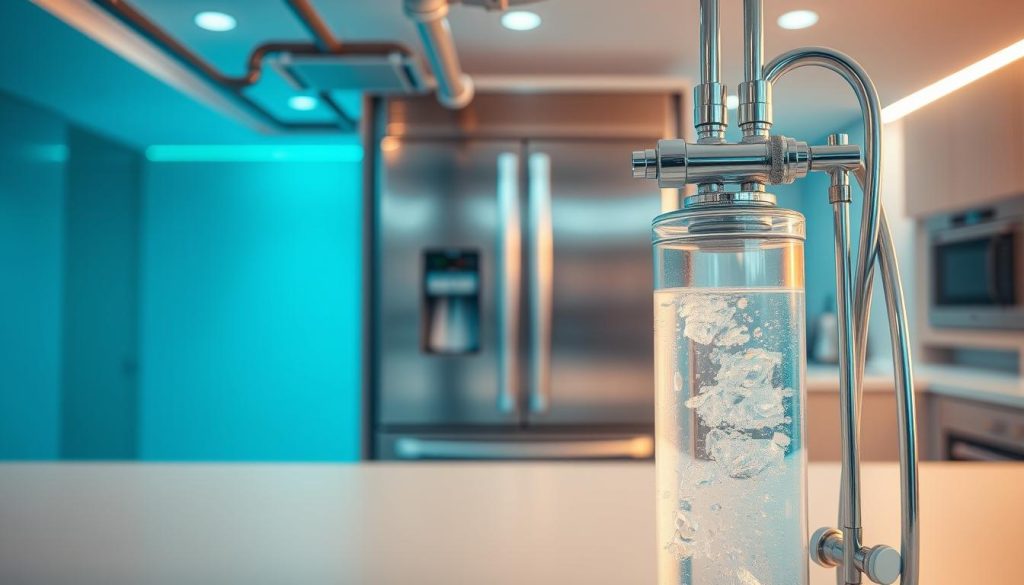
Top Residential Ice Maker Brands Compared
Homeowners looking for the best ice maker need to know about top brands. These brands are known for quality, design, and how well they work.
GE Profile Ice Makers
GE Profile ice makers are sleek and have the latest features. They come in different models to fit any kitchen.
GE Profile Opal Nugget Ice Maker Features
The GE Profile Opal Nugget Ice Maker makes nugget ice, great for special drinks. It’s small and easy to use.
GE Built-In Options
GE’s built-in ice makers look great in your kitchen. They make ice efficiently and fit well with your design.
Frigidaire Ice Makers
Frigidaire has many ice makers, from countertop to built-in. They meet various needs and kitchen styles.
Frigidaire EFIC235 Countertop Model
The Frigidaire EFIC235 is a favorite countertop ice maker. It’s easy to use and doesn’t take up much space.
Frigidaire Gallery Series
Frigidaire’s Gallery Series ice makers have top features and a modern look. They’re perfect for kitchens that want to look high-end.
| Brand | Model | Key Features |
|---|---|---|
| GE Profile | Opal Nugget Ice Maker | Nugget ice production, compact design |
| Frigidaire | EFIC235 | Countertop model, easy to use |
| Whirlpool | WUI75X15HZ | Undercounter installation, high ice production capacity |
| KitchenAid | KUID508HBS | Built-in model, sleek design, high capacity |
Whirlpool Ice Makers
Whirlpool ice makers are easy to use and efficient. They offer models for different kitchen needs.
Whirlpool WUI75X15HZ Undercounter Model
The Whirlpool WUI75X15HZ is an undercounter ice maker. It makes lots of ice and is easy to install.
Whirlpool Portable Options
Whirlpool also has portable ice makers. They’re great for those who need flexibility.
KitchenAid Ice Makers
KitchenAid ice makers are known for their sleek designs and performance. They come in various finishes to match your kitchen.
KitchenAid KUID508HBS Built-In Model
The KitchenAid KUID508HBS is a built-in ice maker. It has advanced features and a modern look, ideal for today’s kitchens.
KitchenAid Design Integration
KitchenAid ice makers fit well in your kitchen. They offer many finishes to match your appliances.
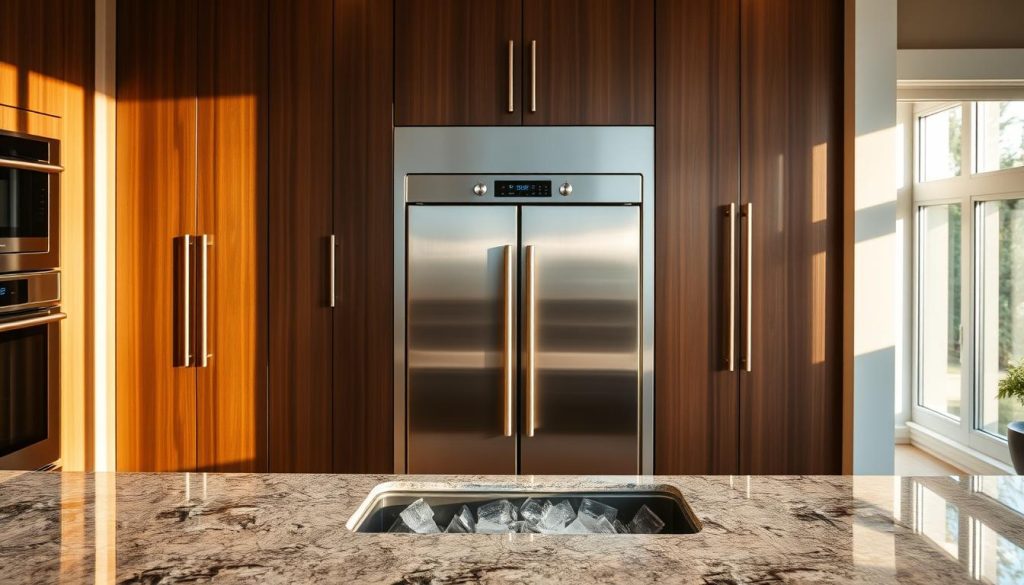
Commercial-Grade Ice Makers for Home Use
If you love to entertain, a commercial-grade ice maker is perfect. These machines are made for big places like restaurants. They can handle lots of ice for your home or parties.
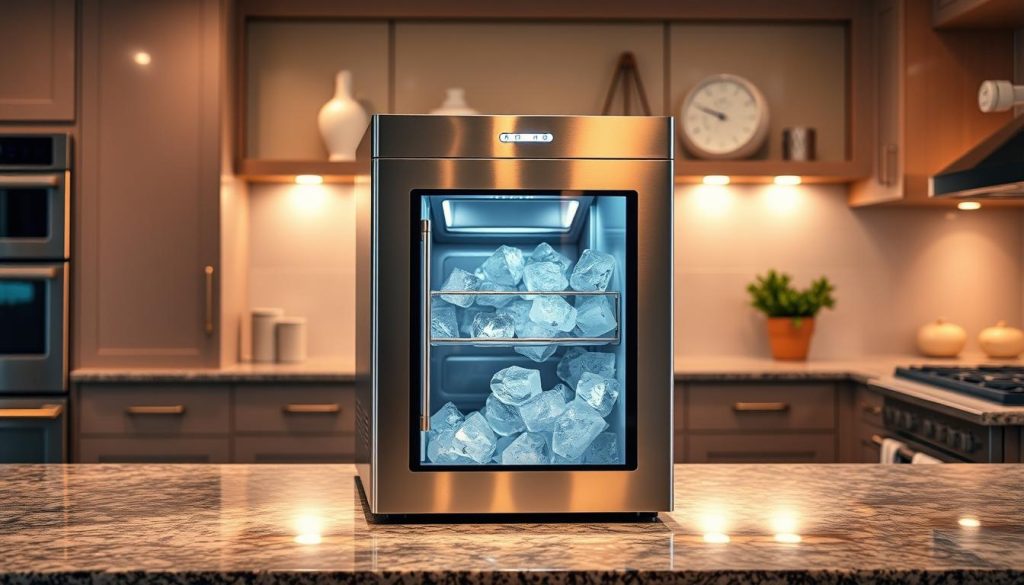
Scotsman Residential Models
Scotsman is famous for its ice makers. They make models for homes that are as good as the ones for businesses. These are smaller but pack a big punch.
Scotsman SCN60 Nugget Ice Maker
The Scotsman SCN60 makes soft, chewable ice. It’s great for drinks. It can make up to 80 lbs of ice a day. It’s also energy-smart and small, fitting well in kitchens.
Scotsman DCE33 Cube Ice Maker
The Scotsman DCE33 makes up to 100 lbs of ice daily. It’s built tough for lots of use. It’s perfect for big parties or gatherings.
Hoshizaki Home Options
Hoshizaki also makes ice makers for homes. Their machines are reliable and make lots of ice. They’re great for homes that use a lot of ice.
Hoshizaki AM-50BAJ Undercounter Model
The Hoshizaki AM-50BAJ fits under counters. It makes up to 50 lbs of ice a day. It’s small but powerful, great for small kitchens.
Hoshizaki C-101BAH Cubelet Ice Maker
The Hoshizaki C-101BAH makes up to 101 lbs of ice daily. It’s efficient and makes lots of ice. It’s perfect for big families or lots of parties.
When picking a commercial ice maker for your home, think about how much ice you need. Look at energy use and how it fits in your kitchen. Scotsman and Hoshizaki have great options for those who need a lot of ice.
Smart Features and Modern Conveniences
Modern ice makers do more than just make ice. They come with smart features that make them easy and efficient to use. Thinking about these features can really improve your experience.
Wi-Fi Connectivity Benefits
Wi-Fi connectivity is a big plus in today’s ice makers. It lets you connect them to your smart home system. This means you can control and check on your ice maker from anywhere.
Remote Monitoring Capabilities
With Wi-Fi, you can keep an eye on how much ice is being made. You’ll get alerts when the ice is ready or if there’s a problem. This is great for making sure you always have ice when you need it.
Smart Home Integration Options
Many ice makers work with popular smart home systems. This lets you control your ice maker from one app. It makes managing your kitchen appliances a breeze.
Programmable Settings and Timers
Modern ice makers also have programmable settings and timers. These let you set up ice production to fit your schedule.
Production Schedule Optimization
By setting your ice maker to make ice at certain times, you can save energy. This is perfect for homes where ice needs change throughout the day.
User Interface Comparison
The way you interact with an ice maker can differ a lot. Some have easy-to-use touch screens, while others have simpler controls. Picking an ice maker with a user-friendly interface can really help with daily use.
| Feature | Basic Model | Advanced Model |
|---|---|---|
| Wi-Fi Connectivity | No | Yes |
| Programmable Settings | Limited | Yes |
| User Interface | Basic Controls | Touch Screen |
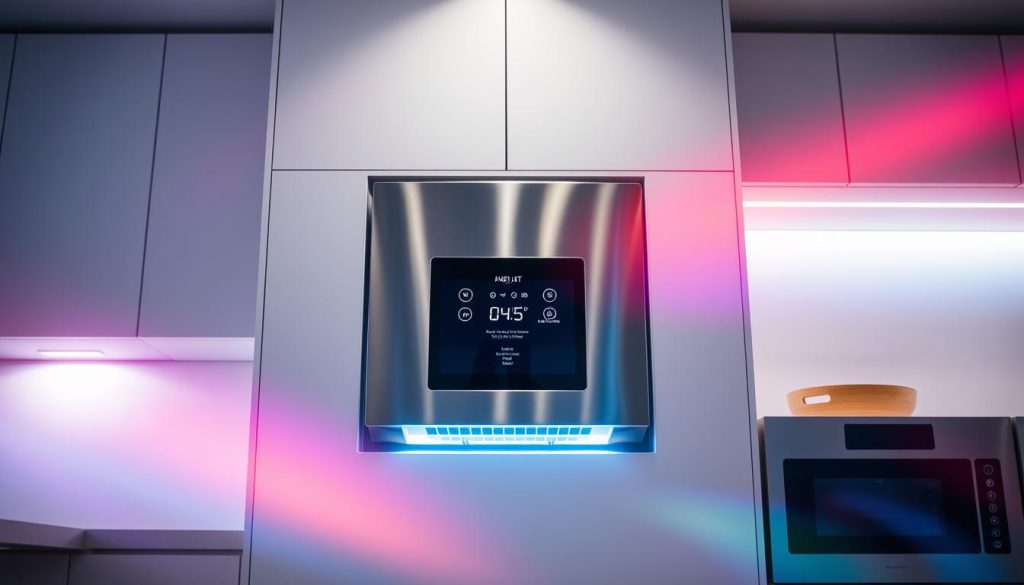
Maintenance Requirements and Cleaning
Keeping your ice maker in top shape is essential for fresh, clean ice. It’s important to keep it clean to ensure great-tasting ice. Regular upkeep not only extends your ice maker’s life but also boosts its efficiency.
Daily and Weekly Maintenance Tasks
For your ice maker to work its best, daily and weekly tasks are key. Always check and swap out the water filter to avoid buildup and bacteria. Also, clean the outside with a soft cloth and mild soap to keep it looking good.
Weekly, check the drain and make sure it’s clear. Some ice makers need you to clean the condenser coils for better efficiency.
Self-Cleaning Models Comparison
Some ice makers can clean themselves, making upkeep easier. These models use a cleaning solution that goes through the system to clear out any debris. When looking at self-cleaning models, think about how often they need cleaning and how simple it is to start the process.
Maintenance Accessibility by Design
The design of your ice maker affects how easy it is to maintain. Models with parts that are easy to remove and access are simpler to clean. Look for ice makers with features like easy-to-take-out ice baskets and accessible drain lines.
Deep Cleaning Procedures
Deep cleaning your ice maker is vital for removing tough buildup and sanitizing it. This involves mixing a cleaning solution with water and running it through the system. Don’t forget to sanitize any parts you can remove.
Descaling Requirements by Brand
Descaling needs vary by brand. Some ice makers need descaling every few months, while others can go longer. Always check your manufacturer’s guide for the right descaling schedule for your model.
Sanitization Best Practices
To sanitize your ice maker, mix water with a sanitizing solution. Run this mix through the system, then rinse well. Regular sanitizing stops bacteria and mold from growing, keeping your ice safe to drink.
Budget Considerations: Price Ranges and Value
It’s important to know the different prices of ice makers. This helps you choose one that fits your budget and meets your needs.
Affordable Options
Ice makers priced between $100-$300 are great for small homes or occasional use. They’re perfect for those who want ice at home without spending a lot.
Best Budget Portable Models
Look for compact, affordable, and energy-efficient portable ice makers. Brands like Frigidaire and GE Profile have reliable models for small kitchens or offices.
Value for Money Analysis
When looking at value, consider how much ice it makes, how much energy it uses, and any extra features. The Frigidaire EFMIS129 is a good choice for its price and performance.
Mid-Range Models
Mid-range ice makers ($300-$800) have more features, capacity, and design. They’re good for bigger families or those who often have guests over.
Feature-to-Price Ratio Comparison
When comparing mid-range models, check for faster ice making, bigger storage, and advanced filters. Whirlpool and KitchenAid models often offer a good mix of features and price.
Best Mid-Range Investments
Choosing a mid-range ice maker like the KitchenAid KCI320SS can be a smart long-term choice. It offers consistent ice and lasts a long time.
Premium Ice Makers
Premium ice makers ($800+) are for heavy use. They have advanced features, sleek designs, and top-quality materials.
Luxury Features Justifying Cost
Luxury ice makers from brands like Scotsman and Hoshizaki have high-end features. These include fast ice making, smart tech, and premium finishes.
Long-Term Value Assessment
Even though premium ice makers cost more upfront, their durability and performance make them a good long-term investment. They’re great for commercial or heavy residential use.
Common Ice Maker Problems and Troubleshooting
Knowing the common issues with ice makers is key to keeping them working well. Problems like not making ice, water leaks, and loud noises can be a hassle. They can also mess up your kitchen’s flow.
Ice Production Issues
Ice makers often face issues with making ice. This can happen for many reasons. Faulty sensors, clogged water filters, or problems with the thermostat are common culprits.
Brand Reliability Comparison
Some ice maker brands are more dependable than others. GE Profile and Whirlpool are known for their reliability. These brands have fewer ice production problems compared to others.
| Brand | Reliability Rating | Average Lifespan |
|---|---|---|
| GE Profile | 4.5/5 | 8 years |
| Whirlpool | 4.3/5 | 7.5 years |
| Frigidaire | 4.1/5 | 7 years |
Quick Fix Solutions
For small ice production problems, quick fixes can help. Check and replace the water filter. Make sure the ice maker is installed right. Cleaning the ice maker parts can also solve the issue.
Water Leakage Solutions
Water leaks are a common problem. They can cause messes and damage. Loose connections, damaged water lines, or faulty valves are common causes.
Design Flaws by Model
Some ice maker models have design flaws that lead to leaks. For example, some models have a higher chance of faulty water inlet valves.
Preventative Measures
To avoid leaks, regular maintenance is essential. Check connections, inspect water lines for damage, and ensure proper installation.
Noise Reduction Tips
Ice makers can sometimes be loud, which can be annoying. Noise can come from improper installation, faulty compressors, or mechanical problems.
Quietest Models Comparison
Some ice makers are designed to be quieter. Models with noise-reducing features or made for home use tend to be quieter.
Installation Techniques for Noise Reduction
Proper installation can greatly reduce noise. Make sure the ice maker is level, securely fastened, and on a stable surface. This helps cut down on noise.
Conclusion: Making the Final Decision
Choosing the right ice maker depends on your kitchen’s needs. Think about how much ice you use daily, the space you have, and what features you want. This helps you pick the best ice maker for your kitchen.
This guide has shown you important factors like how much ice it makes, how much it can store, and how it’s installed. Also, think about the type of ice you prefer. Whether it’s cubes, nuggets, or crescent ice, pick a maker that fits your needs.
Many brands like GE Profile, Frigidaire, Whirlpool, and KitchenAid have different models. You can find one that matches your kitchen’s look and layout. By carefully looking at your options and your budget, you can get a reliable ice maker for your home.
